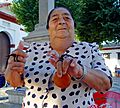Castanets facts for kids
Castanets are cool percussion instruments that come from Spain. You often hear them in an orchestra! They are made from hollowed-out wooden shells. These shells are usually made from strong, hard woods like ebony or rosewood.
How to Play Castanets
Castanets are always played in pairs. Traditionally, a player uses two pairs at once, holding one pair in each hand. A string goes through small holes in the shells. The player wraps this string around their thumb and finger. This lets them click the two shells together to make sound.
The two pairs of castanets are usually slightly different sizes. This makes them produce a slightly different sound. The pair with the higher sound is called hembra (which means female). This pair is usually held in the right hand. The larger pair, which makes a lower sound, is called macho (meaning male). This pair is held in the left hand.
Castanets in Dance and Music
Castanets are often played by singers and dancers. Spanish folk dancers frequently use them. They are especially famous for being part of flamenco dancing, a lively Spanish dance style.
When castanets are played in an orchestra, they are often attached to a stand. This changes how they are played. Instead of holding them, the musician can tap them with their fingers and the palm of their hand.
Castanets are often used in music that wants to sound Spanish. In ballet and opera, they help create the feel of Spanish dances. For example, in Bizet's famous opera Carmen, the character Carmen sings a song and pretends to play the castanets. Usually, the opera singer doesn't actually play them. A percussion player in the orchestra plays the castanets while Carmen acts like she is playing them.
Images for kids
-
Renoir's 1909 painting Dancing girl with castanets
See also
 In Spanish: Castañuelas para niños
In Spanish: Castañuelas para niños



